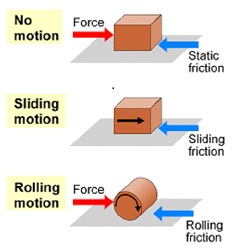

Introduction:
Frictional force is a major idea in physical science that emerges when two surfaces come into contact and communicate with one another. It goes against the general movement or inclination of movement between the surfaces. Frictional forces assume a critical part in different true applications, going from ordinary circumstances to complex mechanical frameworks. In this article, we will investigate various kinds of frictional forces, their particular formulas and conditions.
Static Friction:
Static friction is the force that goes against the underlying movement of an article when it is very still. It holds objects back from sliding against one another. The greatness of static grinding can differ contingent upon the power applied to start movement. The formula to compute static rubbing is:
Fs ≤ μs * N
Where:
Fs is the static frictional force.
μs is the coefficient of static friction, which relies upon the idea of the surfaces in touch.
N is the normal force acting opposite to the surfaces.
Example: Consider a block laying on a slanted plane. To keep the block from sliding, a force is applied lined up with the plane. The greatness of the static frictional force should be equivalent to or not exactly μs * N, where μs is the coefficient of static grinding and N is the typical force applied by the plane.
Kinetic Friction:
Kinetic Friction is the power that goes against the movement of an article that is now moving. It acts when two surfaces slide against one another. The greatness of kinetic friction can be resolved utilizing the condition:
Fk = μk * N
Where:
Fk is the active frictional force.
μk is the coefficient of dynamic friction, which is well defined for the surfaces in touch.
N is the ordinary force acting opposite to the surfaces.
Example: Imagie a wooden block sliding on an even surface. The size of the kinetic frictional force can be determined utilizing the condition Fk = μk * N, where μk is the coefficient of active rubbing and N is the normal force applied on the block because of gravity.
Rolling Friction:
Rolling Friction happens when a round object, like a ball or a wheel, turns over a surface. It is by and large not exactly static or dynamic friction.Rolling Friction can be portrayed utilizing the accompanying condition:
Fr = μr * N
Where:
Fr is the moving frictional force.
μr is the coefficient of Rolling Friction.
N is the normal force acting opposite to the surfaces.
Example: Consider a bike continuing on a street. The moving rubbing between the bike tires and the street not entirely set in stone by the situation Fr = μr * N, where μr is the coefficient of moving friction and N is the normal force applied by the bike out and about.
Conclusion:
Frictional forces are fundamental to comprehend and dissect different actual peculiarities in our day to day routines. By grasping the various kinds of frictional forces and their particular formulas and conditions, we can acquire bits of knowledge into what rubbing means for the way of behaving of items moving. Whether it is the counteraction of sliding or the protection from rolling, frictional forces influence a great many situations. By concentrating on these forces, researchers, engineers, and regular people can upgrade plans, further develop effectiveness, and improve wellbeing in endless applications.